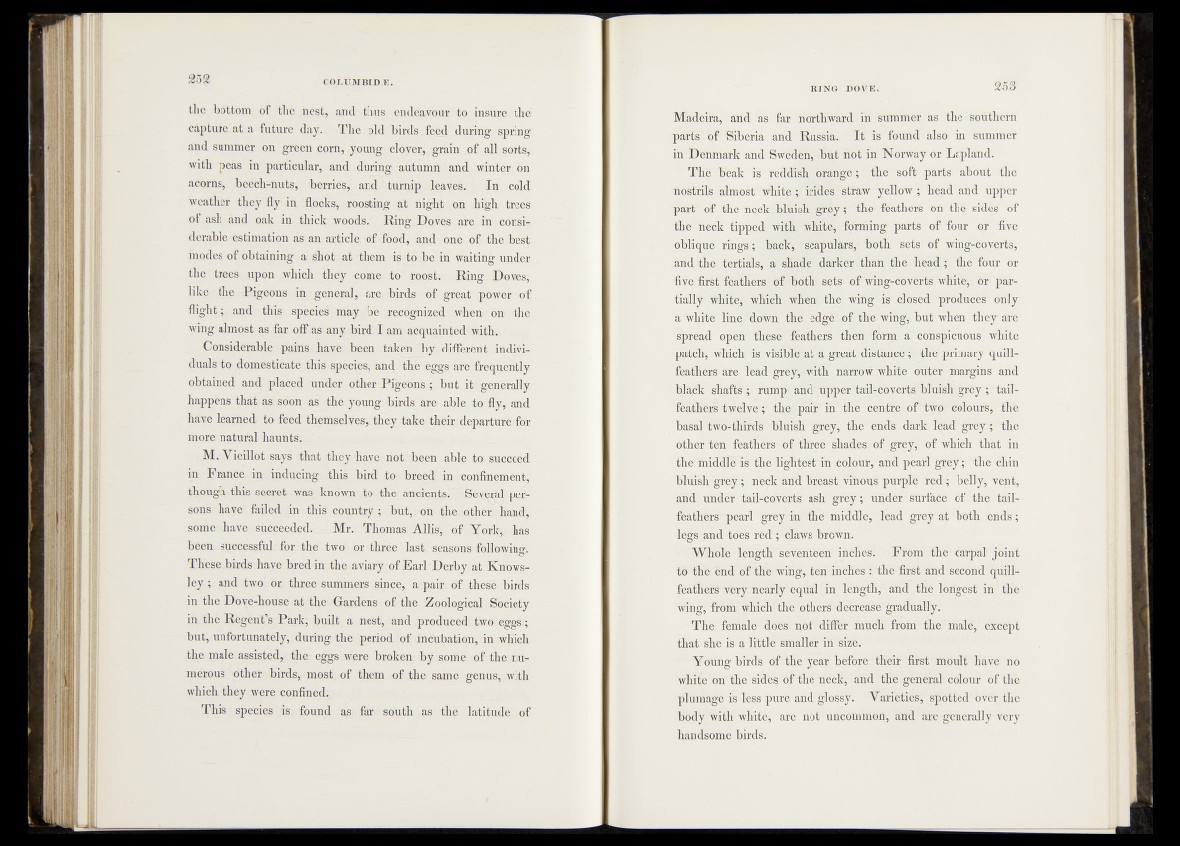
the bottom of the best, and thus endeavour to insure the
capture at a future day.. The old birds feed during spring
and summer on green com * -young eloyer, grain of-all sorts,;
with peas in particular, and during autumn and winter on
acorns, beëófenut^ berriës, and turnip leaves.; In cold
weather they fly in flocks, .roosting • at night on high trees,
of ash and oak in thick woods. Ring, Do,ves ate ih.cdnjsi*
derable estimation as- an articlev of food, and one: of thelbest
inodes, of obtaining a shot., at them is to be in waiting’under
the trees jipon which theyycoine to', roost." Ring. Duves;
bhêi;^e>R%eohs rin general, are. birds of 'great p{^éJ$fo£
flight ; .and' this species may be recognized. wheiir-ron the
wing almost as far o®-as any bird I am acquainted-«■mthV-
_Considerable pains havé been taken'by-different individuals
to domesticate th’is' spècies, and the ;eggS;'are; frequency'
obtained and .placed under- other -Pigeon®but itf%enera;ll:y
happens that as soon; as the young birds lire able tojfiy/ and
have learned to- feed themselvesrthdy take their departure?#?
more natural haunts. /
M^Vieilfet says^|hat they h a y ^ a o t ^ e a ablmto^cceM
%i France in . inducing* .this bird to breed in -rconfinememt,
though this secret, was; known the ancienlpf Several persons;
have Mled.rm.this^<miptry-; butj; on ^ ^ É h ’er "hand,
some have jsucceeded^ - Mr. Thomas 'Alias,!, of .YdrWrhas
beemdsiiccessful for the-two or * three] last seasons: following. V-- f j' ;© v
Thbse birds have bred in the aviary of EarbDerby at-Krip ws-
ley-; and two or! three summers since, a pair of the^x|birds
in the Rove-hou^e at the Gardens ..of thé .Zoological -jBhcierty
ih;thé;Regent’s Park; built: a nest^and .produced two” eggs'; •
but, unfortunately;::during theyperiod’of intubation, in which
the male; assisted, the eggs;were broken; by. sorifri. - of. the niri-
merous other; birds, most, of them of the same genus, with
which, they, were confined;,- ;;
This species is; found vas, far-south as the platitude-of
Madeira, and as far northward in summer as the southern
parts of Siberia and Russia. It is found also in summer
ih Denmark and Swedfen‘,; but not in Norway or Lapland.
T beT beak is’ ’ reddish' Orange ; the soft parts about the
nostrils almost whitejf hides straw y e llow h e a d ahd upper
part of the neclti b jh i^ g r e y ; the feathers on the sides of
thefheck tipped; with white,* forming parts of four or five
pbliqhllhirigs?; back, scapulars; both sets of wing-coyerts,
andThdf tertials,1 a; snade' darker than the head; the four or
fivlffirst/feathers of both set# of win g-c%erts, white, or partially
whit^rWhich when the. Wifig5 is closed' produces only
a white"line”down the. edge’ofr'i®wing,fbuf when they are
spread-opien^ffflM< feathers'then fdrm a conspicuous white
patch, which is visible'at, a great distance'; ■ the primary quill-
>^rahrs are3‘dsM^gle®-1 with narrow wh^g outer margins and
black' snafus; rump and fuppel'i>ail-CQve^s'ibluish'grey ; tail-
feathriil tW'cf^p the'pair in the centre of5 twoColours, the
baiahW^-lhirds blu’illf"grey,- the ends dark lead grey; the
other Tin ■ feaWM-o^tSee* shades? of grey, of which that in
the-middhTts'tlim*Mgntest in colour, ami pearl grey; the ehin
bluish grev^gMjk"and breast vinous purple red; belly;’vept,
and tffiiS^;tail-cdVefefs’. ash under. surface of the tailfcatlims^'
pSirr^^y in th e middfiv lead grey at both ends;
Ilgs^andToyS' red ;'lm|ws brown.
-MHWrofe -length*1 st^riteriir inches^ . From the carpal joint
to’ tfimmnd of the wihgjfeh rn'ch'es ? the ’first and “seCohdr qiiill-
feathers^ Wry^meariymqual in length,- and%,the longest in the
wiffg, from" which the $Merlt?d'eefease gradually.
Thef feihall^dhes not differ much from the male|“ except
’th lt ’sh# il^ f^ f le 1 smaller iriHuzef'®'
YbUng bMf^WtHe^yeat before^ffieir first moult have no
'#H|fe ‘hh'the sidhs^dr*^ neck, and the^'glneral colour of the
plumage i#'leSsjipure and ^ltJssyfX: Varietids^ spotted !bvej; the
bbdy with wmtS, 'are n'6t uncommon, and are generally very
handsome birds.